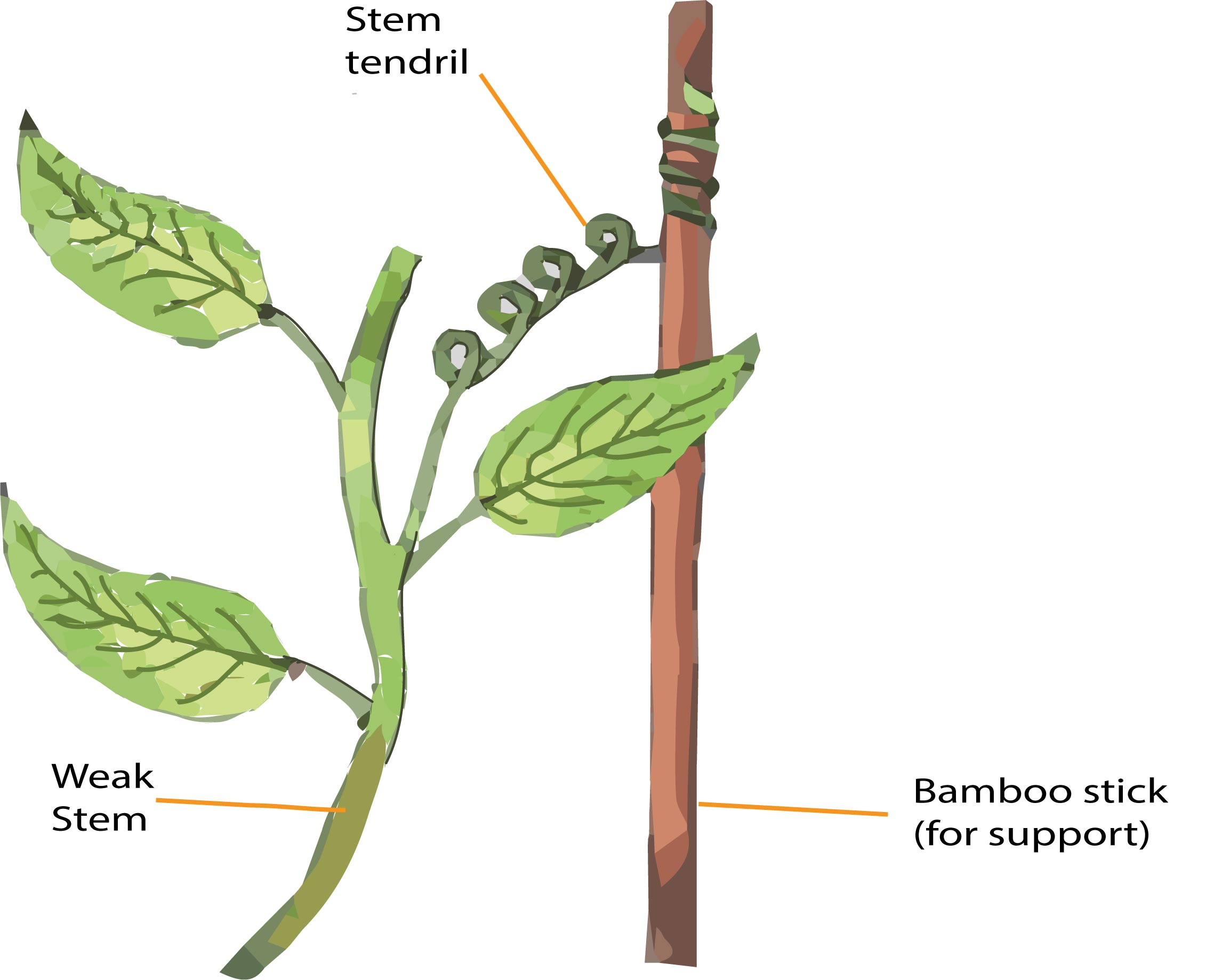
Stem tendrils are seen in
(a)Citrus and bougainvillaea
(b)Citrus and Watermelon
(c)Cucumber and pumpkin
(d)Opuntia and Bougainvillaea
Answer
571.5k+ views
Hint: Tendrils don't have lamina or blade but can carry out photosynthesis. All edible plants from this family are literally fruits, deriving from the ovary of a pollinated flower, although we would call them a 'vegetable.’
Complete answer:
In a stem tendril, the terminal bud is modified to be tendrils where the expansion occurs with the assistance of the axillary buds. This helps the plant body to climb.
Citrus and Bougainvillea contain thorns that originate from the axillary bud of a stem that provides protection.
Watermelon, cucumber, and pumpkin have modified axillary buds that form thin, wiry, leafless, and spirally coiled branches and it helps the weak plant to climb the support referred to as stem tendrils.
Phylloclades are the modified stem that is present in Opuntia which helps them in photosynthesis.
Additional Information: -Stolon: a shoot that grows along the bottom and produces roots at its nodes; a runner
-Tuber: a fleshy, thickened, underground stem of a plant, usually containing stored starch, for instance, a potato or arrowroot
-Cladode: green branches of limited growth which have haunted the functions of photosynthesis
-Rhizome: a horizontal underground stem of some plants that send out roots and shoots from its nodes
-Corm: a brief, vertical, swollen underground stem of a plant that is a storage organ to enable the plant to survive winter or other adverse conditions like drought
-Bulb: the bulb-shaped root portion of a plant like a tulip, from which the remainder of the plant could also be regrown
-Tendril: a thin, spirally-coiled stem which gets attached to a plant to its support
-Thorn: a sharp, protective spine of a plant
-Bulbil: a bulb-shaped bud in the place of a flower or a leaf axil.
So, the correct answer is, “Cucumber and Pumpkin”.
Note: Aerial Stem Modification:
-Tendrils are slender, twining strands that enable a plant (like the buckwheat vine) to seek support by climbing on other surfaces. These can develop from either of the axillary bud or the terminal bud of the stem.
-Thorns are modified branches appearing as hard, woody, sharp outgrowths that protect the plant; common examples include roses, bow wood, and devil’s walking stick.
-Bulbils are axillary buds that have become fleshy and rounded due to the storage of food. They become detached from the plant, fall on the ground, and develop into a new plant.
-Cladodes are green branches of limited growth (usually one internode long) that can perform photosynthesis.

Complete answer:
In a stem tendril, the terminal bud is modified to be tendrils where the expansion occurs with the assistance of the axillary buds. This helps the plant body to climb.
Citrus and Bougainvillea contain thorns that originate from the axillary bud of a stem that provides protection.
Watermelon, cucumber, and pumpkin have modified axillary buds that form thin, wiry, leafless, and spirally coiled branches and it helps the weak plant to climb the support referred to as stem tendrils.
Phylloclades are the modified stem that is present in Opuntia which helps them in photosynthesis.
Additional Information: -Stolon: a shoot that grows along the bottom and produces roots at its nodes; a runner
-Tuber: a fleshy, thickened, underground stem of a plant, usually containing stored starch, for instance, a potato or arrowroot
-Cladode: green branches of limited growth which have haunted the functions of photosynthesis
-Rhizome: a horizontal underground stem of some plants that send out roots and shoots from its nodes
-Corm: a brief, vertical, swollen underground stem of a plant that is a storage organ to enable the plant to survive winter or other adverse conditions like drought
-Bulb: the bulb-shaped root portion of a plant like a tulip, from which the remainder of the plant could also be regrown
-Tendril: a thin, spirally-coiled stem which gets attached to a plant to its support
-Thorn: a sharp, protective spine of a plant
-Bulbil: a bulb-shaped bud in the place of a flower or a leaf axil.
So, the correct answer is, “Cucumber and Pumpkin”.
Note: Aerial Stem Modification:
-Tendrils are slender, twining strands that enable a plant (like the buckwheat vine) to seek support by climbing on other surfaces. These can develop from either of the axillary bud or the terminal bud of the stem.
-Thorns are modified branches appearing as hard, woody, sharp outgrowths that protect the plant; common examples include roses, bow wood, and devil’s walking stick.
-Bulbils are axillary buds that have become fleshy and rounded due to the storage of food. They become detached from the plant, fall on the ground, and develop into a new plant.
-Cladodes are green branches of limited growth (usually one internode long) that can perform photosynthesis.

Recently Updated Pages
Master Class 11 Economics: Engaging Questions & Answers for Success

Master Class 11 English: Engaging Questions & Answers for Success

Master Class 11 Social Science: Engaging Questions & Answers for Success

Master Class 11 Biology: Engaging Questions & Answers for Success

Class 11 Question and Answer - Your Ultimate Solutions Guide

Master Class 11 Business Studies: Engaging Questions & Answers for Success

Trending doubts
10 examples of friction in our daily life

One Metric ton is equal to kg A 10000 B 1000 C 100 class 11 physics CBSE

Difference Between Prokaryotic Cells and Eukaryotic Cells

1 Quintal is equal to a 110 kg b 10 kg c 100kg d 1000 class 11 physics CBSE

State the laws of reflection of light

Explain zero factorial class 11 maths CBSE




